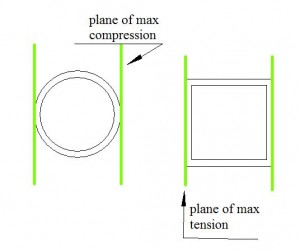When a metal tube is bent, the cross section material fibers experience tension on the outside of the bend area and compression on the inside of the bend area. Wall thickness on the outside cross section of the bend will thin-out due to tensile stresses, because the outer wall tends to be pulled in toward the centerline or neutral axis of the part.
If the ultimate tensile stress of the material is surpassed, then the tube will rip along the outer bend surface. The wall thickness on the inside of the tube bend will thicken due to compressive stresses. If the ultimate compressive strength of the material is reached, the tube will experience localized buckling resulting in rippling of the inside bend surface.
In tube bending you can bend round or square tubing. Round tubing has less material in the most highly stressed regions. The plane of highest tension or compression is tangent to the cross section so it is less prone to distortion. In square tubing the entire tube wall is parallel to this plane and so is exposed to the tensile and compressive stress at the outside and inside of the bend. This makes the square tube more susceptible to distortion.
Round tube allows metal to flow evenly in all directions during the bend which makes it easier to control distortion. Square tube material on the inside of the bend surface has a tendency to expand vertically and flow horizontally along the tube face. These forces behave in a certain way to draw in the vertical edges of the tube distorting the cross section into a concave shape. It is physically tougher to control distortion in a square tube than a round tube. A good rule of thumb when designing curved tubing is that tubes become harder to bend as the outside diameter increases and the wall thickness decreases.








